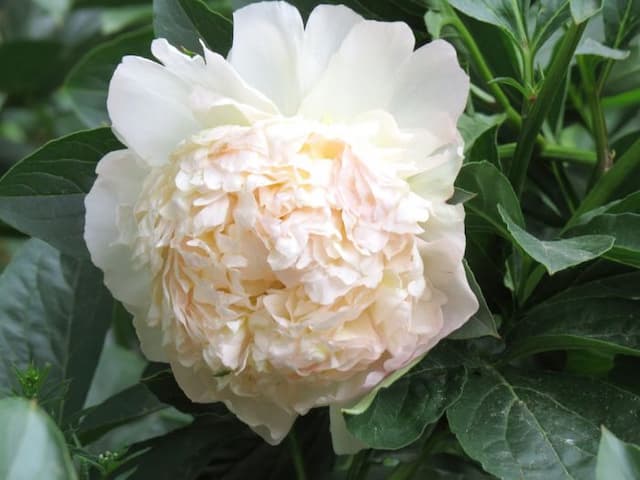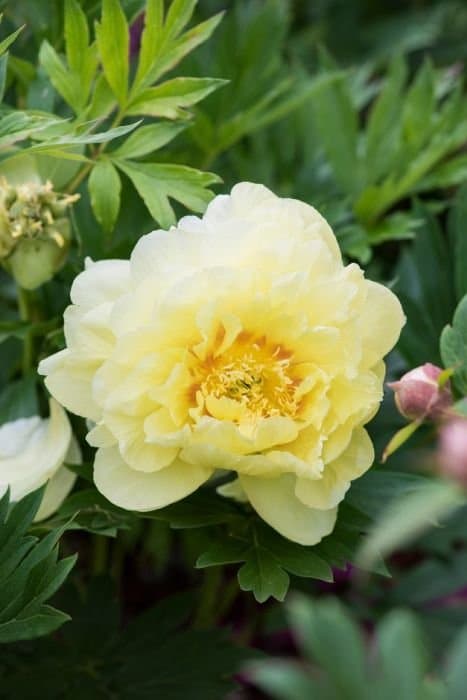Tree Peony Paeonia × suffruticosa (S)

ABOUT
Paeonia x suffruticosa is an upright shrub to around 2m tall with divided leaves; large, variable, cup-shaped, single or semi-double flowers in shades of pink or white are borne in late spring and early summer
About this plant
 Names
NamesFamily
Paeoniaceae.
Synonyms
Tree Peony, Chinese tree peony, Moutan peony.
Common names
Paeonia suffruticosa Andrews, Paeonia arborea Donn, Paeonia moutan Sims, Moutan peony.
 Characteristics
CharacteristicsLife cycle
Perennials
Foliage type
Deciduous
Color of leaves
Green
Flower color
Varies
Height
5 feet (1.5 meters)
Spread
5 feet (1.5 meters)
Plant type
Shrub
Hardiness zones
4-8
Native area
China
Benefits
 General Benefits
General Benefits- Aesthetic Appeal: Paeonia × suffruticosa, commonly known as tree peony, is prized for its large, showy flowers that enhance the beauty of gardens and landscapes.
- Variety of Colors: The tree peony comes in a diverse range of colors, offering numerous options for garden design and personal preferences.
- Longevity: Tree peonies are long-lived plants that can bloom for many years with proper care, providing lasting value to the gardener.
- Seasonal Interest: With a blooming season in the late spring, tree peonies offer a burst of color that can be a focal point in gardens during that time.
- Cultural Significance: In several cultures, especially in Asia, tree peonies have historical importance and are often associated with prosperity and honor, adding a layer of cultural meaning to their cultivation.
- Wildlife Attraction: The vibrant flowers can attract pollinators such as bees and butterflies, promoting biodiversity in the garden.
- Drought Resistance: Once established, tree peonies can be relatively drought-tolerant, reducing the need for frequent watering and making them suitable for xeriscaping.
 Medical Properties
Medical Properties- Anti-inflammatory: Compounds in Paeonia × suffruticosa may help reduce inflammation.
- Analgesic: It has been used traditionally to alleviate pain.
- Immunomodulation: Some studies suggest it can modulate the immune system.
- Antioxidant: Contains antioxidants that may protect cells from oxidative stress.
- Antispasmodic: May relieve muscle spasms.
- Sedative: Traditionally used to help induce relaxation and sleep.
 Air-purifying Qualities
Air-purifying QualitiesThis plant is not specifically known for air purifying qualities.
 Other Uses
Other Uses- Fabric Dyeing: Extracts from the roots and flowers of the tree peony can be used to create natural dyes for textiles, resulting in a range of beautiful colors.
- Cut Flowers: The large and vibrant blooms of the tree peony make it a popular choice for cut flower arrangements to decorate homes and events.
- Gardening Companion Planting: Tree peonies can be planted in gardens alongside other perennials to create aesthetically pleasing color combinations and to attract pollinators.
- Culinary Decoration: The petals of the tree peony, though not commonly consumed, can be used to decorate desserts and salads for an elegant touch.
- Oils for Art: Oil can be extracted from the seeds of the tree peony and is sometimes used in the preparation or restoration of traditional paintings and wood finishes.
- Mood Enhancer: The presence of tree peonies in living spaces is believed to enhance mood and ambiance due to their large, colorful, and fragrant flowers.
- Carbon Sequestration: As a woody perennial, the tree peony can help in capturing carbon dioxide from the atmosphere, contributing to carbon sequestration efforts.
- Soil Erosion Control: The extensive root system of the tree peony can help in stabilizing soil and preventing erosion in gardens and landscaped areas.
- Perfumery: Although not a common use, the scent of tree peony flowers can be captured and used in the formulation of perfumes and scented products.
- Symbolism and Gift-giving: In different cultures, tree peonies are associated with prosperity and honor, making them a thoughtful gift for special occasions.
Interesting Facts
 Feng Shui
Feng ShuiThe Tree Peony is often used in Feng Shui practice for its ability to attract positive chi, promote prosperity, and create a serene environment. It is best placed in the wealth area of a garden or home, which is the southeast, to enhance the flow of energy related to abundance and blessings.
 Zodiac Sign Compitability
Zodiac Sign CompitabilityThe Tree Peony is not used in astrology practice.
 Plant Symbolism
Plant Symbolism- Honor: The tree peony is often associated with honor, especially in Japanese culture where it is considered the "King of Flowers" and symbolizes wealth, good fortune, and high status.
- Prosperity: In China, the tree peony is a traditional floral symbol of riches and honor, and its full bloom signifies prosperity and a flourishing business.
- Romance: Representing love, affection, and feminine beauty, the tree peony is admired for its delicate and large blossoms, making it a popular flower in romantic contexts and weddings.
- Compassion: The lush, full petal spread of the tree peony blossom is sometimes linked with compassion, conveying an open-hearted and generous spirit.
- Good fortune and Happiness: In traditional Chinese culture, the tree peony is seen as a harbinger of good fortune and happiness, especially during the Lunar New Year, when its presence is meant to bring a joyous and prosperous beginning.
 Water
WaterTree peonies, like Paeonia × suffruticosa, prefer well-draining soil and do not like to be overwatered. The plant should be watered deeply once a week, with adaptations made for rainfall, providing about one gallon of water for each watering. During dry spells or in particularly hot weather, water twice a week. It's important not to let the soil become waterlogged, as this can lead to root rot. To prevent issues, ensure the planting area has good drainage.
 Light
LightTree peonies thrive in a location that offers full sun to partial shade. They need at least 6 hours of sunlight a day to bloom well, but in hotter climates, they benefit from afternoon shade to protect the blooms and leaves from intense heat. Dappled sunlight is ideal for regions with strong summer sun.
 Temperature
TemperatureTree peonies are cold-hardy plants, withstanding temperatures down to about 5 degrees Fahrenheit without significant damage. They flourish in a temperature range between 50 and 75 degrees Fahrenheit. These plants can tolerate heat up to around 85 degrees Fahrenheit, beyond which they may show signs of stress.
 Pruning
PruningTree peonies benefit from pruning to remove dead or damaged wood and to shape the plant. The best time to prune is in late winter or early spring before new growth starts. Pruning should be done sparingly, as the plant does not need heavy cutting back. Every few years, remove older stems to encourage rejuvenation.
 Cleaning
CleaningAs needed
 Soil
SoilTree peonies like Paeonia × suffruticosa prefer well-draining, fertile soil with a neutral to slightly alkaline pH, ideally around 6.5 to 7.5. A good soil mix could be equal parts garden soil, well-rotted compost, and perlite or vermiculite to improve drainage.
 Repotting
RepottingTree peonies, like Paeonia × suffruticosa, are slow-growing and seldom need repotting. They can typically remain in the same spot for many years without requiring repotting if planted in the ground.
 Humidity & Misting
Humidity & MistingTree peonies, such as Paeonia × suffruticosa, are tolerant of a range of humidity levels and do well in the typical outdoor humidity found within their growing zones.
 Suitable locations
Suitable locationsIndoor
Tree peonies seldom thrive indoors; they require cold to flower.
Outdoor
Plant in full sun to part shade and sheltered from strong winds.
Hardiness zone
4-8 USDA
 Life cycle
Life cyclePaeonia × suffruticosa, commonly known as tree peony, begins its life as a seed. After germination, the seedling emerges and develops into a young plant, establishing a root system and a foliage of lobed leaves. As it matures, the tree peony forms woody stems and over the years grows into a larger shrub-like form. During spring, the plant enters its flowering stage, producing large, showy blossoms in various colors, which are often highly fragrant. After pollination, the flowers develop into seed pods, which eventually dry and release seeds, completing the reproductive cycle. In winter, the above-ground parts of the tree peony may die back, especially in colder climates, but the plant will re-sprout from the rootstock the following spring.
 Propogation
PropogationPropogation time
Spring
The Paeonia × suffruticosa, commonly known as the tree peony, is typically propagated by grafting, which is the most popular method for this plant due to its effectiveness in reproducing true copies of the parent plant. Grafting usually occurs in late summer or early autumn, but specific timing can depend on your local climate. This process involves taking a piece of a stem, usually with a bud, from a tree peony you wish to clone (known as the scion) and attaching it to the rootstock of a herbaceous peony. The cut surfaces are matched up and bound together, often with grafting tape, until the tissues grow together and form a strong union. Adequate aftercare, such as proper watering and temperature control, is crucial to ensure the success of the grafted plant. Once established, it will grow and develop into a mature tree peony with the same traits as its scion donor.






![Peony [Red Sarah Bernhardt]](/_next/image?url=https%3A%2F%2Fplants-admin.emdemapps.com%2Fimages%2Fplants%2F%2Fimages%2F604b5369d170e.png&w=640&q=75)


